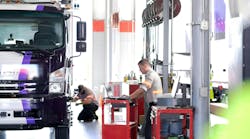As freight volumes begin to pick up across the trucking spectrum, many carriers are revising how they recruit drivers to address a range of issues — everything from changing freight patterns to new safety regulations and demographic shifts in the labor pool.
“Recruiting in 2010 and beyond needs to be very different from what occurred in the past, even just last year,” Mike Hinz, vp-recruiting for Schneider National, told Fleet Owner.
To begin with, said Hinz, today's driver has never been more regulated. He believes that pressure will only intensify on both drivers and fleet managers once the Federal Motor Carrier Safety Administration's Comprehensive Safety Analysis 2010 program starts rolling out in November. Second, freight is now becoming far more regionalized. “It used to be we focused on finding ‘coast-to-coast’ or long-haul drivers. More manufacturers now want to shorten their supply chains, so we're witnessing a boom in regional freight,” he explained.
As a result, some 40% of Schneider's 14,000 drivers are now in regional operations. To even out the workload, Schneider hopes to hire 2,500 drivers for its five regional operations by the end of this year.
“The customer demand for our regional service has exceeded our expectations and created enough freight density to get [these] drivers home weekly,” Hinz noted. “And work-life balance is more important than ever to today's professional truck driver.”
One would think that this change alone would drive an influx of younger workers into an industry where the average age for truck drivers hovers around 47. But Hinz said that's not been the case. “We will always need and see younger drivers, but right now we're actually seeing older workers who are transitioning from other industries,” Hinz said. The experience of those workers shifting from fields such as manufacturing, high tech and even office work can translate well to trucking. “In many cases, veteran workers with their career experiences are better able to master the challenges and conflicts of the job,” Hinz added.
As a result, carriers such as Transport America are changing how they recruit drivers. “We're trying to get away from centralized recruiting, to send more pre-qualified candidates directly to our terminals to get a flavor for the jobs in their area,” Brett Terchila, director of operations for Transport America, told Fleet Owner.
While the work history and driving record remain critical, Terchila said other key points now include technological know-how as well as job expectations. “A big piece of what we're doing is an ‘expectation exchange,’” he noted. “We want to know what the driver expects of the job and to convey to them our expectations. We set standards on both sides, for them and for us, at the outset.”
Transport America now measures a matrix of metrics that it shares on an ongoing basis with its drivers; these include safety, on-time delivery, out-of-route mileage, idle time, and fuel economy. “Our goal is to coach drivers to achieve what we need,” Terchila explained. “We put a lot of emphasis on training our fleet leaders in order to help them engage with drivers, to create a more positive give-and-take to change behaviors instead of marching them out the door.”


